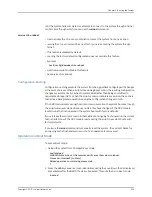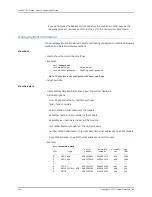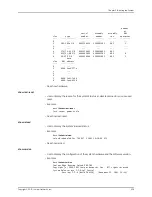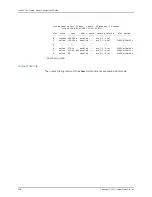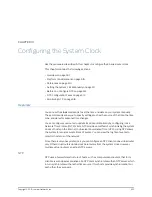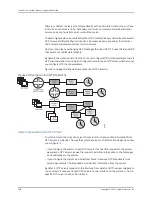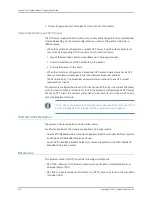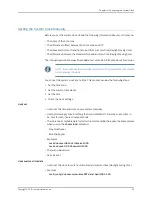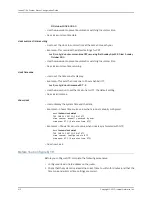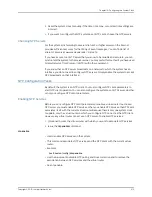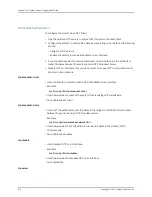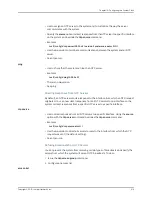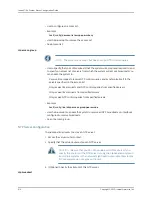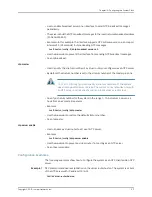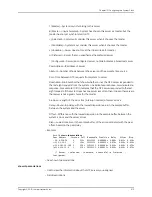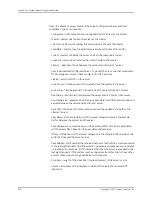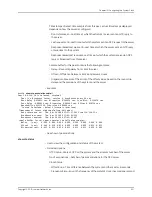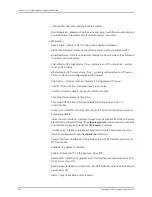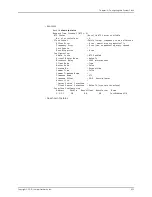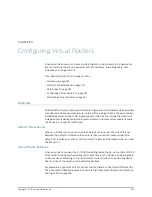
3.
The system gradually synchronizes its clock to that of the master.
System Operation as an NTP Server
The NTP server supports both unicast (user-to-user addressing protocol) and broadcast
modes. Depending on the server configuration you choose, the system functions in
different ways:
•
When the system is configured as a unicast NTP server, it synchronizes clients to its
own clock by responding to NTP requests from clients as follows:
1.
Swaps the destination and source addresses in the request packet.
2.
Sets all timestamps and NTP attributes in the packet.
3.
Returns the packet to the client.
•
When the system is configured as a broadcast NTP server, it periodically sends NTP
time synchronization messages to the local network broadcast address
(255.255.255.255). The broadcast server would also respond to any NTP unicast
requests from clients.
If the system is configured both as an NTP client and an NTP server, the system effectively
synchronizes its clients to its master’s clock. If the system is configured as an NTP server
but not an NTP client, the system synchronizes its clients to its own clock, which can be
set by the
clock
commands.
NOTE:
When the system is not configured as either an NTP client or an NTP
server, it responds to NTP requests with an invalid stratum number.
Platform Considerations
The system clock is supported on all E Series routers.
For information about the modules supported on E Series routers:
•
See the
ERX Module Guide
for modules supported on ERX7xx models, ERX14xx models,
and the ERX310 Broadband Services Router.
•
See the
E120 and E320 Module Guide
for modules supported on the E120 and E320
Broadband Services Routers.
References
This implementation of NTP meets the following specifications:
•
RFC 1305—Network Time Protocol (version 3) Specification, Implementation and
Analysis (March 1992)
•
RFC 2030—Simple Network Time Protocol (SNTP) (Version 4) for IPv4, IPv6, and OSI
(October 1996)
Copyright © 2010, Juniper Networks, Inc.
510
JunosE 11.3.x System Basics Configuration Guide
Summary of Contents for JUNOSE 11.3
Page 6: ...Copyright 2010 Juniper Networks Inc vi...
Page 8: ...Copyright 2010 Juniper Networks Inc viii JunosE 11 3 x System Basics Configuration Guide...
Page 24: ...Copyright 2010 Juniper Networks Inc xxiv JunosE 11 3 x System Basics Configuration Guide...
Page 32: ...Copyright 2010 Juniper Networks Inc 2 JunosE 11 3 x System Basics Configuration Guide...
Page 146: ...Copyright 2010 Juniper Networks Inc 116 JunosE 11 3 x System Basics Configuration Guide...
Page 166: ...Copyright 2010 Juniper Networks Inc 136 JunosE 11 3 x System Basics Configuration Guide...
Page 432: ...Copyright 2010 Juniper Networks Inc 402 JunosE 11 3 x System Basics Configuration Guide...
Page 488: ...Copyright 2010 Juniper Networks Inc 458 JunosE 11 3 x System Basics Configuration Guide...
Page 524: ...Copyright 2010 Juniper Networks Inc 494 JunosE 11 3 x System Basics Configuration Guide...
Page 554: ...Copyright 2010 Juniper Networks Inc 524 JunosE 11 3 x System Basics Configuration Guide...
Page 566: ...Copyright 2010 Juniper Networks Inc 536 JunosE 11 3 x System Basics Configuration Guide...
Page 588: ...Copyright 2010 Juniper Networks Inc 558 JunosE 11 3 x System Basics Configuration Guide...
Page 613: ...PART 3 Index Index on page 585 583 Copyright 2010 Juniper Networks Inc...
Page 614: ...Copyright 2010 Juniper Networks Inc 584 JunosE 11 3 x System Basics Configuration Guide...
Page 632: ...Copyright 2010 Juniper Networks Inc 602 JunosE 11 3 x System Basics Configuration Guide...








